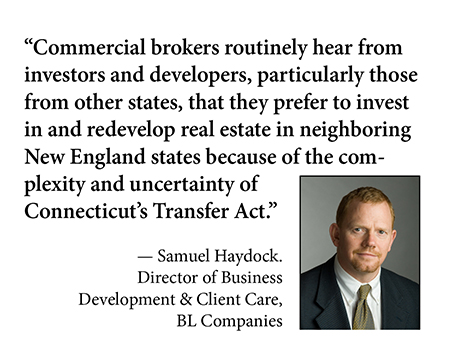By Samuel Haydock, business development and client care – environmental services, BL Companies.
Connecticut’s industrial past and subsequent decline has left the state dotted by abandoned factories and associated pollution — contaminated soil, groundwater, abandoned buildings and neighborhood blight.
The impact can be seen across the state, from urban centers like Waterbury and Bridgeport that have block after block of brownfields to rural communities such as Plainfield and New Milford, where the town was developed around mills or factories that now sit vacant and dilapidated.
While Connecticut has led the way in recent years with significant funding for assessment and remediation of brownfields to jumpstart redevelopment, the state still suffers from a reputation as having environmental regulations that thwart investment and growth.

How We Got Here
The main culprit is an environmental statute known as the Connecticut Transfer Act. Passed in 1985 as a “buyer beware” law to disclose the presence of pollution and protect buyers from unwittingly purchasing cleanup liability, the law has — whether fairly or unfairly — been blamed for the creation of brownfields and the lack of investment needed to revitalize them.
Ask any commercial real estate broker about the Transfer Act, and he or she will be quick to say it kills deals. They routinely hear from investors and developers, particularly those from other states, that they prefer to invest in and redevelop real estate in neighboring New England states because of the complexity and uncertainty of the Transfer Act. Even experienced, veteran developers who are not afraid of contaminated properties cite the cost and unpredictability of the Transfer Act as reasons for bypassing Connecticut.
The problems with the Transfer Act became apparent almost immediately after passage. Initial issues included a huge backlog of properties entered into the Connecticut Department of Energy & Environmental Protection (CTDEEP) Property Transfer Program. This was exacerbated by insufficient agency staff and the absence of uniform cleanup standards.
The act immediately created an uneven playing field for real estate owners and business, as only certain types of properties — dry-cleaners, automobile body repair shops, furniture strippers and properties where hazardous waste was generated — that are defined as Establishments are subject to the provisions of the law.
Even worse, the act is only triggered by transfer of a business or real estate, which had the unintended impact of leaving many commercial and industrial properties vacant and abandoned. Legislative fixes have included the passage of the Remediation Standard Regulations (RSRs) in 1996 and the implementation of the Licensed Environmental Professional (LEP) program, as well as annual tweaks to the statute itself to try and make it more user-friendly.
New Regulatory Developments
In recent years, the calls by property owners, brokers, the business community and municipal and state economic development entities to eliminate the Transfer Act have grown, and even leaders at the CTDEEP recognized it was time for change.
In 2019, Public Act 19-75 modified the Transfer Act to provide businesses that are not routine generators of hazardous waste with an exemption from the requirement to file under the Transfer Act. This exemption centered around one-time generation of hazardous waste or the production of hazardous waste that was associated with closing a facility or shutting down a business.
In 2020, Public Act 20-09 made additional revisions designed to keep properties or businesses that don’t meet the definition of an Establishment from having to meet obligations under the Transfer Act. This was accomplished by clarifying the investigation and remediation requirements for multi-tenant and industrial condominium properties.
The changes require only investigation and remediation — if necessary — of the portions of multi-tenant properties and industrial condominiums that are occupied or utilized by the Establishment.
The classic example is the sale of a dry-cleaning business in a shopping center. Prior to the passage of Public Act 20-09, the sale of a dry-cleaning business would have triggered a full investigation of all potential release areas at the shopping center, not just those associated with the dry-cleaning business. Now, the investigation and potential remediation are limited to potential release areas from the dry-cleaning business only.
More importantly, Public Act 20-09 also set in motion the development of a new set of release-based remediation regulations, which upon passage will result in the sunset of the Transfer Act. The new regulations will apply to both new and historical releases discovered at a property. The requirement for certain properties to be investigated and potentially remediated simply based on the sale of a business or real estate will be eliminated.
Development of the new release-based remediation regulations has been underway through a stakeholder engagement process that has been ongoing for 30 months. Stakeholders engaged in the process include LEPs, environmental attorneys, property owners, real estate brokers, environmental advocates and CTDEEP staff. The stakeholder engagement process has identified a framework for the new regulations that will begin with discovery of a release and move through reporting requirements, characterization requirements, immediate response actions, cleanup, monitoring and closure.
As part of the process, 10 subcommittees, two ad-hoc teams and two drafting teams have provided advice and feedback on these topics as well as other complicated and sometimes-contentious issues. These include how to handle releases at residential properties; complications caused by the presence of urban fill that contains regulated compounds unrelated to a specific release; the use of non-LEPs to close lower risk releases; and the increased use of risk assessment as a tool to close releases, to name a few.
Looking Ahead
While there is general agreement on the overall framework and the substantive topics, the devil will be in the details. After 30 months of the advice and feedback process, CTDEEP has not released any written drafts for any portions of the new regulations. The agency hopes to have draft regulations for review and comment by the fourth quarter of 2023, with possible adoption in 2024.
However, significant work remains to be done to finalize and pass the proposed release-based remediation regulations. Not only must the regulations themselves be drafted and accepted by the stakeholders and ultimately the Connecticut Legislature, but as many as 20 to 30 additional regulations and statutes may also require revision.
Amid the effort to eliminate the Transfer Act, CTDEEP has been busy with other initiatives, including revisions to the RSRs and the environmental land use restriction process; the development of new spill reporting regulations; revisions to the underground storage tank (UST regulations); and a more conservative position regarding the “applicability” of these regulations to properties with pollution. While some of these changes and revisions have been helpful and necessary, the “applicability” issue represents a significant departure from over 20 years of implementation of the RSRs and raises concern about the direction of the new regulatory framework.
While the existing regulatory framework that is largely driven by the Transfer Act is unpopular and often blamed for the lack of investment in Connecticut, the jury is out on whether the new regulatory framework without the Transfer Act will be better or worse. There is little doubt that the new framework will be protective of human health and the environment. The question is whether it will create a workable scenario for practitioners and allow for predictability in costs and time frames for cleanup releases. This is critical for attracting developers and allowing for continued investment in Connecticut’s towns and cities.
For property owners and real estate investors in Connecticut, staying informed on the development of the proposed regulations, participating in public meetings and discussing concerns with legislators is paramount. In the meantime, while the transition plays out, property owners and investors should work with knowledgeable and experienced environmental consultants who are tracking the transition and can advise on real estate transactions and other environmental matters.


